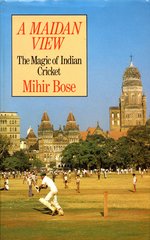A Maidan View
David Mutton |Published: 1986
Pages: 179
Author: Bose, Mihir
Publisher: George Allen and Unwin
Rating: 2.5 stars

Before play on the fourth day of the first test between India and England the Indian broadcaster cut to a short feature sponsored by a car company. A young reporter drove to Mahatma Gandhi’s ashram and spoke with a few tourists about the great man’s legacy. He signed off by concluding that although Gandhi preferred walking he would surely have enjoyed his company’s car, with its fuel efficiency, comfort and excellent features.
If India, and its national sport, has changed even in the few years since the formation of the IPL. then there has been a veritable revolution since 1986, when Mihir Bose put pen to paper with his thoughts on Indian cricket. The country has won a second World Cup and, briefly, held the test match mace. It has emerged as the game’s centre of power, and its national heroes have become advertising fodder. Bose’s book (which was revised and republished in 2006) attempts to grasp India’s relationship with cricket in the interregnum after their first World Cup win and before their ascent to financial rulers of the game.
The result is a hodge-podge. Pages rush by without any reference to cricket. Context is all well and good but after pages on the formation, structure and behaviour of the Indian middle class I almost questioned whether this was a cricket book at all. When Bose finally reaches his point he unleashes an exposition about how the clash between new money in Bombay and the old guard, who were custodians of the genteel Brabourne Stadium, resulted in the creation of the Wankhede Stadium. This pattern runs through the book: lengthy tracts on India interrupted by excellent observational nuggets. These include why cricket rather than football was the national sport, a detailed analysis of the role of the princely states and a sympathetic portrait of the last of the cricketing princes, Mansur Ali Khan Pataudi.
The book comes alive when Bose relates his own stories and anecdotes. There is a loving description of childhood gully cricket with his friend, Hubert, and their progression onto the maidans of south Bombay with a rag-bag team that cut across the city’s economic and social divides. Several excellent photos capture the busy but ordered world of the maidan. Bose also writes about his school, St. Xaviers, which Sunil Gavaskar attended. Although Gavaskar was not a prodigy (unlike Sachin Tendulkar, who scored 326 not out against St. Xaviers), the sports master saw his ability, telling Bose and his friends “You are just two nice chaps. You’ll never be cricketers. That boy will be a great cricketer.”
The book feels like an erudite journalist’s equivalent of an over-extended pub conversation. Bose writes lucidly and makes sharp points about the state of the game, alongside loving reminisces of his childhood cricket obsession. But these are stretched too thinly to warrant even this fairly short book (it runs to 179 pages) and so the space is filled with Bose’s pet theories on the state of India. The result is a frustrating experience but a useful insight into the state of Indian cricket, or at least the mentality of Indian fans, as it was beginning its climb towards the highest echelons of the game.






Leave a comment